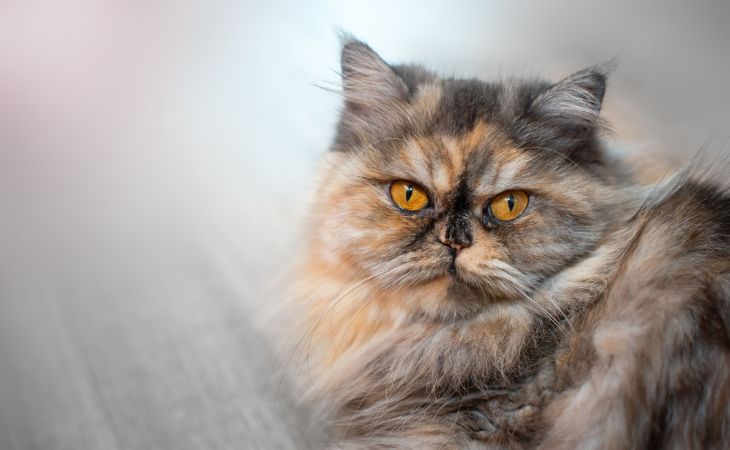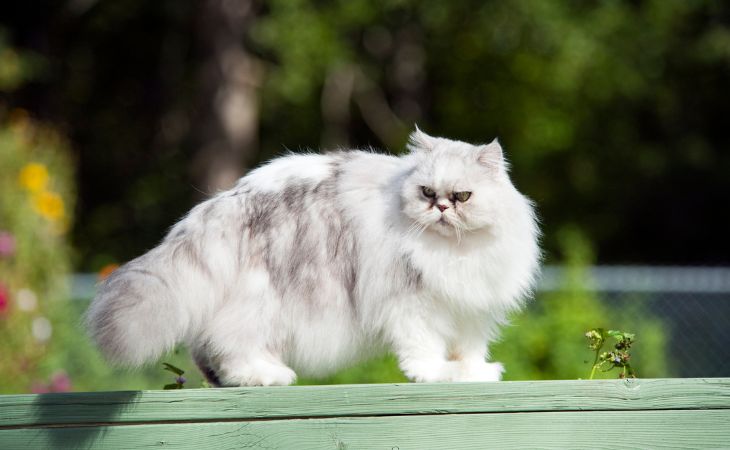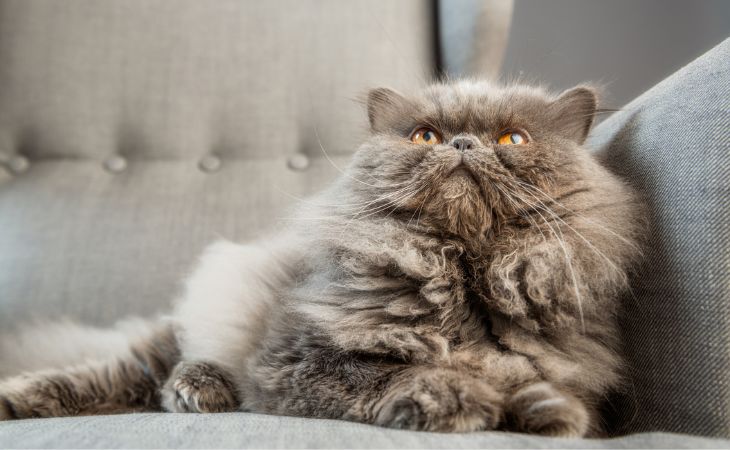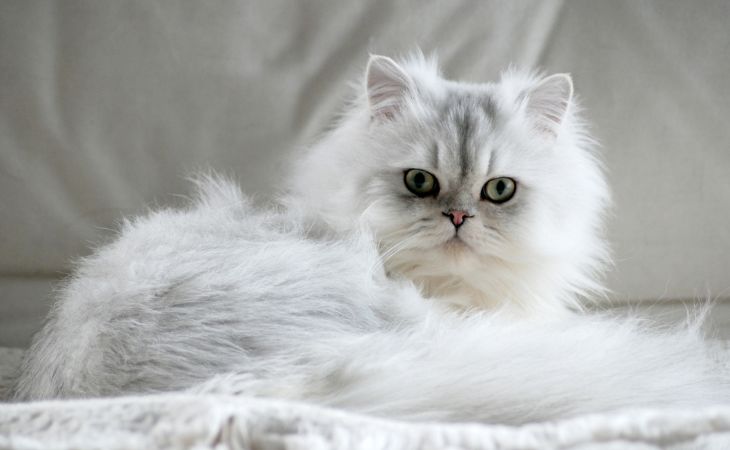Breed standard: CFA, FIFe, TICA, WCF, FFE, ACF, ACFA/CAA, CCA-AFC, GCCF, LOOF | Size: Medium | Average lifespan: 12+ years | Temperament: Calm, gentle, and sociable | Coat: Long | Origin: England.
The Persian cat is a calm, gentle, sociable, and peaceful cat.
The origins of the Persian cat
One of the oldest cat breeds
As the Persian cat is one of the oldest cat breeds in the world, the exact origins of the breed are still a mystery. This is because the registers do not go back to the original creation of the breed. With that being said, traces of the Persian cat have been found, proving that the breed has been here for several centuries.
The only well-documented record of the breed tells of the arrival of the Persian cat in Italy in 1620 by Pietro Della Valle. Pietro Della Valle was a merchant who regularly imported jewelry, spices, and silk from Persia. It is believed that these cats reproduced in Italy and were then brought to France where they were loved by women of the bourgeoisie.
During the same time period, Nicholas-Claude Fabri de Peiresc (1580-1637) brought a couple of long-haired cats to France. These cats originated in the Damas in Syria. The cats were named Turkish Angoras after the former name of the capital of Turkey. Contemporaries thought that the breed that was brought to Italy and the breed that was brought to France were one and the same. Turkish Angora cats were generally white.
Other theories state that the Persian cat was the result of a cross between cats that originated in Egypt. Their history is believed to be told in hieroglyphics that were discovered in tombs in Ancient Egypt.
The Persian cat is also believed to have another ancestor. A cat breed that originated in Khorasan with a long gray coat. The cat is a blue variety of the Turkish Angora cat.
The Persian cat: from the 19th century to today
England is the first country to start Persian cat selection. During the 19th century, the first crosses were realized between Turkish Angoras that were already present in England and other types of European cats. It was decided to select only round, heavy, brevilinear cats with an accentuated stop. By doing this, they moved away from the thin cat that was known as the Turkish Angora. Objectives regarding the morphology and fur of the breed were achieved by the British in the 1850s.
In Great Britain, the Persian cat breed was very popular. Exoticism was in fashion and the atypical features of this breed made people absolutely adore this cat. These cats were successively called the “French cat”, the “Chinese cat” and the “Indian cat”. In the end, the breed was simply named longhair to reference the cat’s long fur coat.
A breeding program was put in place by the British. They decided to cross the longhair of the time with the British Shorthair in order to obtain a cat that was more round. They did a lot of long work with the goal to improve the quality of the coat and round out the silhouette of the cat. Lastly, they worked on diversifying the coat. The first Persian cats were one color, but by the end of the 19th century, other colors appeared. It was possible to find parti-colored Persian cats, tabby, smoke, Chinchilla, Shaded Silver and Shaded Golden Persian cats.
The Persian cats that we know today were created at the end of the 19th century by English breeders. They were created by realizing crosses between long-haired cats who originated in the Middle East (the original Persian) and English cats with short fur.
The first ever feline cat show to present the Persian cat took place in 1871 during the first feline cat show at the Crystal Palace in London. The first breed standard was then written in 1889.
The Persian’s peke-face
In the United States, the selection of cats was the most extreme. Persian cats were so popular that Americans decided to continue the work of the English and go further in the extremes regarding the form and colors of the breed.
They chose cats that were even more compact, and ended up with a Persian cat with a peke-face in the 1930s. This new variety of cats caused a lot of controversy in Europe. Some defended the English variety while others were supporters of the American model.
The development of the Persian cats that were too typified like the peke-face was slowed down because these varieties seemed to be less appreciated. They presented physical particularities like a flat face and round eyes. These cats often have eye problems, caused by the bad functioning of their lacrimal and respiratory canals.
The popularity of the Persian cat
During the 2000s, the Persian cat was the most popular cat breed in multiple countries. However, the Persian cat is getting less and less popular because of the popularity of the Maine Coon and the Bengal.
In France, a third of the cats registered in 2007 were Persian cats. In England and in the United States, they have been in fourth place since 2006. It is, however, the only breed whose registrations in the LOOF have decreased by more than a quarter between 2003 and 2007.

The character of the Persian cat
The qualities of the Persian cat
The Persian cat is a calm, gentle, sociable, and peaceful cat breed. They can live well and happily in an apartment. This cat is also discrete and meows very rarely.
As these cats can get very attached to their owners, they need attention and do not hesitate to ask for cuddles. They are playful but greatly appreciate spending many hours sleeping.
Are there any downsides to having a Persian cat?
Persian cats prefer to have a routine that is perfectly regulated and do not appreciate changes or disruptions to their habits. For example, they like to eat at the same time every day.
They are sometimes rather solitary cats. While they appreciate hugs, they prefer to be the ones to decide when they receive them. Otherwise, they like to have moments to themselves.

The physical characteristics of the Persian cat
General
The Persian cat is a medium cat with long and thin fur. They also have a thick undercoat that is characteristic of the breed. Males can weigh up to 7 kilos (≈ 15.4 pounds) and females can weigh up to 6 kilos (≈ 13.2 pounds). Their body is held up by short and stocky legs. They can have thin tufts of hair in between their toes.
This breed reaches puberty quite late. They start after they reach a year old and sometimes more for certain males. When it comes to their maturity, it is reached around the age of 2 years.
Head
The head of the Persian cat is round and massive. Their skull is large and forms a dome. The face of the Persian cat is round with a gentle expression and rounded bone structure. When it comes to the cheeks, they are large and powerful with prominent and full cheekbones. From the side, their forehead, nose, and chin are aligned on the same vertical axis.
Their nose is large and very short, with the nostrils open enough for their respiration to not be bothered. The stop is well-defined and deep. It must be in between the eyes, ideally in the middle. It should never be higher than the superior line of the eyes and never lower than the inferior line of the eyes.
The muzzle must be round, large, and full. This cat has a perfect occlusion of the jaws and the chin must be strong.
When it comes to the eyes, they are round, large, and well-spaced away from each other. They have a gentle look. The color of the eyes must be as intense as possible and coincide with the color of the coat.
Their ears are roundish, small, not too wide at the base and well-spaced away from each other. They are placed in a way that respects the roundness of the head. The inside of this cat breed’s ears must have ear furnishings.
Body
The neck of the Persian cat is thick and massive, but short. Its head seems to be attached to its shoulders.
The body is cobby and massive with the shoulders and the hips rounded and the same size. The back is straight and the chest is large. The thoracic cage and the abdomen are rounded. These cats need to be muscular and should not show any obvious obesity.
Their legs are short, robust, and strong. They are also very straight. Their paws are round and massive and can have tufts of hair in between their toes.
Lastly, their tail is short, thick at the base, and ends with a rounded end. The tail is proportionate to the length of the body. It should have an abundant amount of fur.

Coat, color, and care
The Persian cat’s coat
The Persian cat has a long coat. Its coat is long on the body, even on the shoulders. The fur is dense, thin, and silky. They have an abundant undercoat that gives volume to their entire body. The Persian also has a very developed collar that continues between the front legs and under the belly.
The colors of the Persian cat
Practically every color is accepted for the Persian cat.
- Single-colored: black, white, red, blue, chocolate, lilac, cream.
- Mink.
- Colorpoint.
- Shaded Silver.
- Cameo.
- Shaded Golden.
- Shell.
- Smoke.
- Tabby.
- Particolored (bicolor or tricolor).
Taking care of the coat
The Persian cat has a long and thin coat. This requires the owner to take care of the coat every day. It is necessary to brush this cat’s coat daily to maintain the good health of their coat and to avoid the formation of knots and balls of fur.
It is also necessary to check their ears and eyes regularly because they are sensitive and their eyes can water. Their face should be cleaned at least once per week.
You might also enjoy reading this article: 15 things you didn’t know about the Persian cat
Did you know?
- The Exotic Shorthair, which was created at the end of the 1960s in the United States, is the short-haired variety of the Persian cat.
- The Persian cat is the cat breed that is abandoned the most. 70% of the total amount of cat breeds that are abandoned are Persian cats. This high percentage of abandonment is linked to their care which is tedious and their health issues.
- It is the most popular breed in France and in several other countries.
The Persian cat at a glance
Size: Medium. Adult Persian cats measure around 30 cm (≈11.8 in) at the withers.
Weight: Between 3 and 6 kilos (≈ 6.6 and 13.2 pounds).
Health: When it comes to this cat breed’s health, the Persian cat is very fragile. You need to be attentive to this cat’s needs to keep them in good health. Their flat nose makes them prone to respiratory diseases. They are also fragile when it comes to their kidneys and their eyes. In addition, they can suffer from various diseases like feline corneal sequestrum, feline fibroadenomatous, adenomas, hypertrophic cardiomyopathy, genetic skin infections, and polycystic kidney disease.
They also need constant attention when it comes to their coat. They should be brushed daily and it’s also important to keep an eye on their sensitive ears.
Concerning their diet, they are very strict and need to follow it closely. They are also prone to obesity.
Average lifespan: 12 to 16 years.
Is the Persian cat good with children? The Persian cat is calm and peaceful. However, they will appreciate calm moments. It is important to educate children to respect these cats’ personal space and to not bother them when they want to be at peace. This is a cat that doesn’t like to be bothered and is not exactly playful.
Is the Persian cat easy to live with? This cat is very easy to live with because they are relatively independent and do not stick to you like glue. However, you should always keep an eye on their grooming and health.

